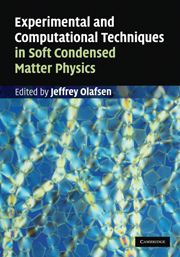Book contents
- Frontmatter
- Contents
- Contributors
- 1 Microscopy of soft materials
- 2 Computational methods to study jammed systems
- 3 Soft random solids: particulate gels, compressed emulsions, and hybrid materials
- 4 Langmuir monolayers
- 5 Computer modeling of granular rheology
- 6 Rheological and microrheological measurements of soft condensed matter
- 7 Particle-based measurement techniques for soft matter
- 8 Cellular automata models of granular flow
- 9 Photoelastic materials
- 10 Image acquisition and analysis in soft condensed matter
- 11 Structure and patterns in bacterial colonies
- Index
- References
11 - Structure and patterns in bacterial colonies
Published online by Cambridge University Press: 05 July 2014
- Frontmatter
- Contents
- Contributors
- 1 Microscopy of soft materials
- 2 Computational methods to study jammed systems
- 3 Soft random solids: particulate gels, compressed emulsions, and hybrid materials
- 4 Langmuir monolayers
- 5 Computer modeling of granular rheology
- 6 Rheological and microrheological measurements of soft condensed matter
- 7 Particle-based measurement techniques for soft matter
- 8 Cellular automata models of granular flow
- 9 Photoelastic materials
- 10 Image acquisition and analysis in soft condensed matter
- 11 Structure and patterns in bacterial colonies
- Index
- References
Summary
Introduction
Though the movement of a single, isolated bacterium is reasonably well understood, when a large number of interacting bacteria are put together they produce beautiful and often complex phenomena. “Large” here typically means from 106 to 1012 individual cells: a small population by thermodynamic standards, but certainly unwieldy for any except statistical descriptions. Even restricting ourselves to the simple system of bacteria moving on or in solidified agar plates, the colony structures produced are surprisingly rich. In dilute solutions, swimming cells move independently, interacting with each other through their common consumption of a reservoir of nutrient. A point source of swimming cells expands in concentric rings as successive waves of bacteria chase gradients of nutrients, sometimes condensing into regular geometric patterns by chasing self-generated gradients. More concentrated solutions of swimming cells interact hydrodynamically through the fluid, producing large-scale swirls reminiscent of turbulence. This swirling occurs in two-dimensional surface motility as well, where uncorrelated motion turns into large-scale swirling as surface density increases. At extremely high density, bacteria jam and stop moving, as occurs in colloids. These high densities occur naturally on hard surfaces, where colony expansion is driven by cell growth rather than by motion; as the surface property becomes softer and wetter and bacteria begin to move, the resulting colonies change from fractal-like to radially symmetric and finally to a form dominated by a fast-growing, single-cell-thick outer layer.
- Type
- Chapter
- Information
- Publisher: Cambridge University PressPrint publication year: 2010
References
- 3
- Cited by



